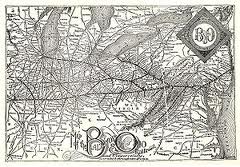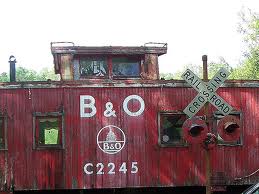The Historic Baltimore & Ohio Railroad
Part 2: The End of the Line
As with the rebuilding that happened all over the country after the end of the Civil War occurred, the B&O made extensive repairs to its network and infrastructure in the late 1860s, including laying new track west from Washington, D.C. The railroad also got into the merger craze in a big way. As one of the country's larger organizations, the B&O was on the receiving end of many offers from smaller outfits that were finding it hard going as the 20th Century approached. Rail lines in Illinois, Indiana, Missouri, New York, Ohio, Pennsylvania, Virginia, and West Virginia came under the B&O banner. Such rapid expansion, coupled with uneven economic conditions during Reconstruction, resulted in many struggles between railroad workers and management, as in other railroads and other businesses. In 1877, the B&O cut wages twice. The result was the Great Railroad Strike of 1877. Unrest was so widespread that the governors of Maryland and Pennsylvania called out the state militia to sort it out. Riots resulted, involving 15,000 at Camden Station and hundreds of others at other stations, and dozens of people were killed. The arrival of federal troops calmed the scenes. As the 20th Century dawned, the B&O was the first railroad to feature an electric locomotive (in 1895). Such innovations did not save the railroad from bankruptcy, however. The Pennsylvania Railroad purchased controlling interest of the B&O in 1901. The subsequent infusion of cash and capital produced resulted in much-needed repairs and expansion of rolling stock. Bridges and tracks were upgraded as well. In the early 20th Century, the B&O introduced diesel power in its locomotives and air conditioning and reclining seats in its cars.
The B&O underwent another management change in 1963, after its acquisition by the Chesapeake and Ohio Railway. The company merged the two with the Western Maryland Railway in 1973 to create the Chessie System. Seven years later, they were all folded into the CSX Corporation, along with even more railroads. The B&O remained independent until 1987, when it was formally dissolved fully into CSX. Remnants of the Baltimore & Ohio Railroad can be seen throughout the country and in historical collections, most notably in the B&O Railroad Museum. |
|
Social Studies for Kids
copyright 2002–2025
David White



 In 1861, the B&O owned thousands of railroad cars and more than 500 miles of track, and all were south of the Mason-Dixon Line. Maryland was a "border state" that did not join the Confederacy. Nevertheless, many Marylanders sympathized with the Southern cause, many actively. The management of the B&O, however, supported the Union, and so the railroad served as a main hub for shipping people, goods, and weapons around Union territory. Realizing this, Confederate General Stonewall Jackson struck immediately after the war began, cutting railroad and telegraph lines and burning bridges and railcars. As a result, the railroad was out of action until March 1862. Repairs were made, the trains ran again, Confederate troops struck again, repairs were made, and on it went. In all during the war, nearly 150 raids and battles involved the B&O in some form or fashion.
In 1861, the B&O owned thousands of railroad cars and more than 500 miles of track, and all were south of the Mason-Dixon Line. Maryland was a "border state" that did not join the Confederacy. Nevertheless, many Marylanders sympathized with the Southern cause, many actively. The management of the B&O, however, supported the Union, and so the railroad served as a main hub for shipping people, goods, and weapons around Union territory. Realizing this, Confederate General Stonewall Jackson struck immediately after the war began, cutting railroad and telegraph lines and burning bridges and railcars. As a result, the railroad was out of action until March 1862. Repairs were made, the trains ran again, Confederate troops struck again, repairs were made, and on it went. In all during the war, nearly 150 raids and battles involved the B&O in some form or fashion. With the advent of other forms of motorized transportation, most notably trucks and airplanes, railroads were no longer the first choice for passengers or shipping companies. As a result, what had been a sometimes sprawling variety of competing companies became a series of amalgamations by companies in order to try to stay viable in a world of changing priorities.
With the advent of other forms of motorized transportation, most notably trucks and airplanes, railroads were no longer the first choice for passengers or shipping companies. As a result, what had been a sometimes sprawling variety of competing companies became a series of amalgamations by companies in order to try to stay viable in a world of changing priorities.
